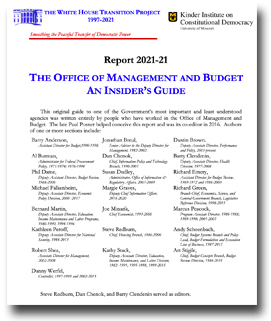
The Road to Working With OMB: An Insiders’ Guide

Blog Co-Authors: Steve Redburn, Professorial Lecturer, The Trachtenberg School of Public Policy and Public Administration, George Washington University and Barry Clendenin, Adjunct Faculty, Schar School of Policy and Government, George Mason University
A host of major issues will face the Nation’s leadership following this November’s election, including the continued response to and recovery from COVID-19 and ongoing policies to drive economic growth. The Administration in office after January 2021 will face extraordinary demands to address these and other economic and societal pressures.
To help new leaders succeed, anyone arriving in the West Wing or named to another senior policy position needs to quickly understand the workings of the Office of Management and Budget (OMB) and what it does for the Presidency. But few people arrive with this critical knowledge. As Paul O’Neill, a former OMB deputy director, once said: “One of the interesting things about OMB is that it is unexplainable to everyone who lives outside of the Beltway and misunderstood by nearly everyone who lives inside the Beltway.”
To help fill in this knowledge, a volunteer group of former OMB senior executives has put together a volume that provides important insights. Their collective effort is called OMB, An Insider’s Guide. This work updates a similar volume issued in 2016. It has been published by the White House Transition Project.
If a new President is elected, soon after the outcome of the election is known and before the presidential inauguration on January 20, 2021, OMB staff will work with both the incoming President’s transition teams and the outgoing President’s staff to promote a smooth transition. Fewer than 500 career staff at OMB will help provide continuity and analytical and technical expertise to support the agenda of the President. OMB has the institutional knowledge and skills needed for the critical step of working with White House and agency officials to create the materials that go into the President’s budget. OMB’s regulatory and management staff and legal office have complementary roles to play in changing and developing policies in their areas of responsibility to implement the President’s agenda.
The Insider’s Guide offers a short history of how the responsibilities and structure of OMB have changed, even as its staff retains a commitment to the highest standard of service to the presidency – to helping each administration achieve its policy priorities and meet new challenges. This includes helping the President prepare a budget by identifying key issues and challenges and the options for addressing these. OMB also acts as a clearinghouse for presidential communications throughout the Administration and with Congress. And OMB provides leadership on many dimensions of policy implementation and management.
The second part of the Guide describes the work of major OMB offices that oversee policies in areas that include regulation, procurement, financial management, information technology, and performance and personnel. The current work of these and other OMB offices will be of special interest to those aiming at or named to one of these positions.
We thank the authors of this work, and hope it provides an informative guidepost for future leaders in OMB and other offices that support the Presidency.



